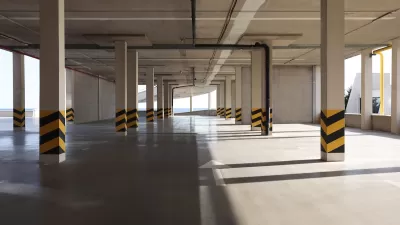Too much parking and too much transit creates a glut of unneeded parking. Of course, this is by design - that is, zoning design, where Downtown Brooklyn developers are required to accommodate new residents of their new buildings with large garages.
Thomas Kaplan writes about a problem that many auto-dependent cities and suburbs could only dream of having - a glut of parking - auto parking, that is.
"The issue, officials say, lies with the large garages that the developers of new residential buildings have been required by zoning rules to construct. But with 13 subway lines and 15 bus routes in the area, many new residents choose to leave their cars behind, meaning the garages sit half-empty and take up precious space."
“People are choosing to live in Downtown Brooklyn because of the great access to the public transit network that they find there,” said Tucker Reed, the president of the Downtown Brooklyn Partnership. “The last thing we need to be doing is developing more parking.”
The City is listening. On Dec. 3, "a City Council panel is scheduled to consider new zoning regulations that would reduce how many parking spaces must be built with new residential developments in Downtown Brooklyn, and allow developers who already have excess parking to reclaim the unneeded space for other uses. (Because there are so many subway tunnels and other infrastructure in that part of Brooklyn, many of the garages are above ground, making it easier to use the space for something else.)"
However, the lessons learned in Downtown Brooklyn, the "third largest central business district in New York City" according to Wikipedia, may not be applicable elsewhere. Car ownership of residents may be a key indicator as to how much parking to require developers to provide.
"Residents in Downtown Brooklyn are likelier than those in many other neighborhoods to go car-free: 22 percent of households in the neighborhood own cars, according to the Census Bureau, compared with 45 percent for the city over all.
Under current rules, developers of new residential buildings in Downtown Brooklyn must provide parking spaces for at least 40 percent of households. The minimum parking requirement would drop to 20 percent under the new rules, and there would be no requirement to build parking with subsidized housing units, a move that supporters said would reduce the cost of building such units."
As for the parking needs of other vehicles, the Planning Commission was not receptive to "Brooklyn borough president, Marty Markowitz, call for the zoning rules to be adjusted to increase the requirements for providing bicycle parking by 50 percent."
"The Planning Commission concluded that requiring additional bicycle parking was beyond the scope of the zoning changes that were being considered."
Thus, when it comes to parking, only vehicles with four wheels and an engine are considered.
FULL STORY: City Takes Up Zoning Changes to Erase Downtown Brooklyn’s Glut of Parking Spots

Planetizen Federal Action Tracker
A weekly monitor of how Trump’s orders and actions are impacting planners and planning in America.

Map: Where Senate Republicans Want to Sell Your Public Lands
For public land advocates, the Senate Republicans’ proposal to sell millions of acres of public land in the West is “the biggest fight of their careers.”

Restaurant Patios Were a Pandemic Win — Why Were They so Hard to Keep?
Social distancing requirements and changes in travel patterns prompted cities to pilot new uses for street and sidewalk space. Then it got complicated.

Platform Pilsner: Vancouver Transit Agency Releases... a Beer?
TransLink will receive a portion of every sale of the four-pack.

Toronto Weighs Cheaper Transit, Parking Hikes for Major Events
Special event rates would take effect during large festivals, sports games and concerts to ‘discourage driving, manage congestion and free up space for transit.”

Berlin to Consider Car-Free Zone Larger Than Manhattan
The area bound by the 22-mile Ringbahn would still allow 12 uses of a private automobile per year per person, and several other exemptions.
Urban Design for Planners 1: Software Tools
This six-course series explores essential urban design concepts using open source software and equips planners with the tools they need to participate fully in the urban design process.
Planning for Universal Design
Learn the tools for implementing Universal Design in planning regulations.
Heyer Gruel & Associates PA
JM Goldson LLC
Custer County Colorado
City of Camden Redevelopment Agency
City of Astoria
Transportation Research & Education Center (TREC) at Portland State University
Camden Redevelopment Agency
City of Claremont
Municipality of Princeton (NJ)




























